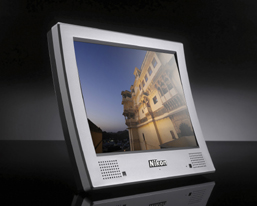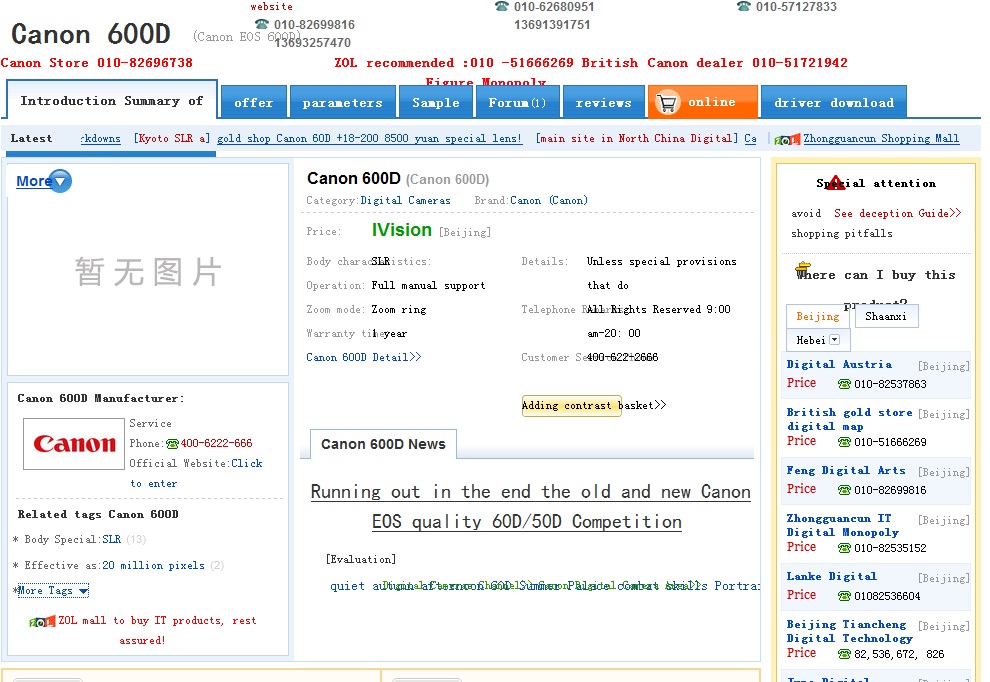Join More Than 50,000+ Subscribers and get latest camera news and rumors
NEW CAMERA VIDEOS ON YOUTUBE
|
By admin, on October 27th, 2010
3D image conversion service that enables viewing of high-quality 3D images without specialized eyewear on a dedicated 3D digital photo frame
TOKYO – Nikon Corporation and Nikon Imaging Japan Inc. are pleased to announce the launch of my Picturetown 3D, a new 3D imaging service that offers 3D image conversion over the Internet for viewing of 3D images on a dedicated 3D digital photo frame.
my Picturetown 3D is a service for registered members that offers a 3D image conversion service available from Nikon’s my Picturetown, an online image sharing and storage service, and supports viewing of 3D images without specialized eyewear on the new NF-300i 3D digital photo frame. The primary services offered are as follows.
- Loan of an NF-300i 3D digital photo frame
- 3D image conversion of still images stored on my Picturetown
- Viewing and sharing services for 3D image utilizing my Picturetown functions
- Distribution of 3D contents (still photos and movies) with my Picturetown
 These services not only allow users to view their photos in dynamic 3D format, but also enable the sharing of 3D images between NF-300i 3D digital photo frames. These services not only allow users to view their photos in dynamic 3D format, but also enable the sharing of 3D images between NF-300i 3D digital photo frames.
What’s more, the Android mobile operating system has been adopted for the NF-300i 3D digital photo frame, enabling the inclusion of functions other than simple image viewing, including a calendar, a clock and display of weather information. my Picturetown 3D is only available in Japan.
Features
1. The NF-300i 3D digital photo frame for enjoying high-quality 3D images without specialized eyewear
2. 3D image conversion service and distribution of 3D contents with my Picturetown
3. Viewing of special Magnum Photos contents for a limited time
4. Advanced NF-300i 3D digital photo frame application
Service overview
| Name: |
my Picturetown 3D |
| URL: |
http://3d.mypicturetown.com/ |
| Application for service: |
Begins October 26, 2010 |
| Service launch: |
Early in December, 2010 |
| Fee: |
¥1,995* (tax included) per month or ¥19,950* (tax included) per year |
Website Link: http://3d.mypicturetown.com/
By admin, on October 27th, 2010
Start a Mudfight with the PENTAX Optio W90 and a chance to win a $400 American Express gift card.

Click on the image to Join the Mud-Fight
PENTAX Imaging Company announced today the launch of the PENTAX Optio W90 MUDFIGHT CHALLENGE. Centered around the company’s award winning waterproof camera, the MUDFIGHT CHALLENGE APP dares Facebookers around the globe to test their skills at a brand new sport – virtual mud throwing.
Participants* may visit: http://apps.facebook.com/mudfight/ and muck it up with Facebook friends, family, or those pesky frenemies. Facebookers who play may become eligible to win a $400 American Express gift card. *Participation is limited to current Facebook members. Sign-up is free at www.facebook.com.
MUDFIGHT CHALLENGE is easy to play. Once loaded, the APP randomly helps players select five Facebook friends. Next, users access a computer mouse to target the crosshair aim as friends pop up randomly. Every hit drives up the score and helps players ascend to higher levels of play while top scores are recorded on a leaderboard. Facebookers are entered into the sweepstakes each time they play.* *(Up to 50 times per day.)
Covered in questionable substances from the start, the PENTAX Optio W90 mud obsession originated to communicate the adventure-proof features of the camera. The APP is one of several consumer marketing initiatives to promote the adventurous camera in the midst of a global media shift from traditional to digital and social. PENTAX Imaging launched www.facebook.com/pentax about one year ago. More than 20,000 (and growing) facebookers indicate they “like” the site on the home page.
“There is no longer one right way to engage consumers,” said Ned Bunnell, president, PENTAX Imaging Company. “This comprehensive campaign, designed by The1stMovement, our recently selected digital advertising agency of record, uses a combination of interactive and social media components to help us build stronger relationships with more customers.”
“Providing engagement with the PENTAX brand through a social media game is a natural extension of the Optio W90 initiative,” said Ann Van Orsdel, president of The1stMovement. “Reaching our audience where they spend their time, helps reinforce our product message and key benefits in a way that is both fun and relevant.”
Along with MUDFIGHT, PENTAX and The1stMovement recently unveiled “THE MOST ADVENTUROUS FRIEND YOU KNOW” campaign for the Optio W90 that encompasses:
• Home page animated flash enhancements to www.pentaximaging.com to communicate the features of the Optio W90 and all of the latest PENTAX digital cameras.
• Digital and traditional billboards and train wraps posted in downtown Minneapolis near the TWINS Stadium on the cusp of the holiday shopping season.
• Targeted online integrated, taunting rich media banner ads that feature the Optio W90 as “THE MOST ADVENTUROUS FRIEND YOU KNOW” encouraging viewers to create an adventure of their own and step outside their comfort zone.
• The leveraging of a variety of social media advertisements and a targeted pay-per-click campaign.
• Several fresh, new product videos on www.youtube.com/pentaxian1 that entertain while demonstrating product features and applications.
By admin, on October 25th, 2010

Update from DMC-FZ100 Firmware update service
Improvement of banding noise or shadow which may occur depending on the outdoor shooting condition
Click here to visit contest website
By admin, on October 23rd, 2010

Sigma has announced a firmware update for its DP1x compact camera.
Benefits from new Firmware
Ver. 1.01
- Corrects the phenomenon that recording time is rather long.
- Shortens the time of turning on and off.
*Please note; this firmware cannot be used with the SIGMA DP1 and SD DSLR series cameras.
Click here to Download
By admin, on October 23rd, 2010
 Apple today introduced iLife ’11, a major upgrade that gives Mac users even more great ways to create and share photos, movies and music. iPhoto ’11 has a whole new look, with stunning full screen modes for Faces, Places and Events. iMovie ’11 makes it easier than ever to edit videos and quickly transform them into fun theatrical trailers for easy posting online. GarageBand ’11 introduces new ways to improve your playing and create great sounding songs with Flex Time and Groove Matching. Free with every new Mac, iLife ’11 is available as a £45 upgrade for existing users. Apple today introduced iLife ’11, a major upgrade that gives Mac users even more great ways to create and share photos, movies and music. iPhoto ’11 has a whole new look, with stunning full screen modes for Faces, Places and Events. iMovie ’11 makes it easier than ever to edit videos and quickly transform them into fun theatrical trailers for easy posting online. GarageBand ’11 introduces new ways to improve your playing and create great sounding songs with Flex Time and Groove Matching. Free with every new Mac, iLife ’11 is available as a £45 upgrade for existing users.
“iLife is widely regarded as the best suite of ‘Digital Life’ applications in the world, and iLife ’11 makes them even better”, said Steve Jobs, Apple’s CEO. “iLife now makes it easier than ever to create books and letterpress cards, make amazing movie trailers from your personal videos and post them online, and make your band sound far better or teach yourself piano or guitar”.
iPhoto ’11 features stunning new full screen modes that take advantage of your Mac’s brilliant display for browsing, editing and showcasing your photos. Sharing your photos is easier than ever in iPhoto ’11, whether you send them by email using one of eight beautiful themes, post them to your Facebook wall with a single click, or play them in full screen with one of 12 professionally designed slideshows. iPhoto ’11 features a completely new approach to creating books and cards with a sleek carousel interface, intelligent book layout and a bookshelf that displays all your projects. New letterpress cards let you combine your photos and text with elegant imprinted designs to create unique wedding invitations, birth announcements, holiday greetings and more.
iMovie ’11 helps you turn your videos into captivating Hollywood-style trailers that are fun to watch and share. You can choose from 15 different genres including Adventure, Romantic Comedy and Epic Drama, each one complete with its own unique titles, graphics and cinematic soundtrack. Powerful new tools make it easy to selectively adjust audio levels and apply sophisticated visual effects like flash and hold, instant replay and jump cuts with a single click. People Finder analyses your videos and marks sections containing faces, so you can quickly find the perfect clips for your trailer or movie. iMovie ’11 also adds exciting new themes that make your videos look like professional news or sports programs.
GarageBand ‘11 includes two new ways to fix or change the timing of your recordings. Flex Time lets you move, stretch or shorten individual notes by clicking on just the part of the audio waveform you want to change, without affecting the rest of the recording. With Groove Matching, you can select any track as the “Groove Track” and all other tracks will instantly match its rhythmic feel. GarageBand ’11 adds seven authentic-sounding new guitar amps, five fun new stompbox effects, and 22 new Basic Lessons for piano and guitar. The new “How did I Play?” feature listens while you play along with any lesson, highlights mistakes and tracks your progress to help you become a better musician.
Pricing & Availability
iLife ’11 is available immediately for a suggested retail price of £45 inc VAT (£38.30 ex VAT) through the Apple Store (www.apple.com/uk), Apple’s retail stores and Apple Authorised Resellers. The iLife ’11 Family Pack includes five licenses and is available for £69 inc VAT (£58.72 ex VAT) and the Mac Box Set which includes iLife ’11, iWork and Mac OS X v10.6 Snow Leopard is available for £119 inc VAT (£101.28 ex VAT).
iLife ’11 requires Mac OS X version 10.6.3 or later, a Mac computer with an Intel processor, 1GB of RAM, a DVD drive for installation and 5GB of available disk space. iPhoto print products and GarageBand Artist Lessons are sold separately and are available in select countries. Full system requirements and more information on iLife ’11 can be found at www.apple.com/uk/ilife.
By admin, on October 23rd, 2010
Latest Rumors regarding Canon EOS 600D.
Below is the latest webpage snapshot of a chinese website >> rumors regarding the Canon EOS 600D,
Click on the image to enlarge

Website link http://bit.ly/aEW5FQ
Please tell us how credible you believe these to be, and feel free to add your own comments/thoughts.
By admin, on October 23rd, 2010

Internationally-renowned provider of digital lifestyle innovations, BenQ, expands the lineup of their camcorder product line today with the launch of their latest pocket-size 1080p Full HD M11. The new M11 is packed with features such as a 10MP CMOS sensor; 5x optical zoom and 3.0” 16:9 touch-screen display. Sensational results are a few touches away.
Smart engineering, functionality and intuitive operation gracefully merged to work together in M11: touch exposure; face tracking; time lapse recording; slow-motion and accelerated playback; 3sec pre-recording and dual stream recording are only few of its inexplicable features – along with the scene mode selection allowing its users to change and select up to 10 shooting modes: Auto; Night; Sports; Landscape; Portrait; Sunset; Sand /Snow; Flower; Firework and Aquarium. Giving the consumer’s the ability to record their precious moments in life with ease.
One of the prominent functions in M11 is the Time Lapse Recording feature. M11 allows users to create magnificent video works with this handy feature, engrossing clips of actions slowly being unfolded can be captured. Watch a flower bloom, a rainstorm approach, a city’s dusk till dawn. Videos recorded in this mode can be quickly viewed and take up little storage space.
Viewing experience on the M11 is exceptionally flexible, actions on the videos can be slowed down to as little as 1/64th of the original speed, or sped up by up to 64 times when filmed at the resolution of 432×240. Playback at the speed you like, and capture certain shots with ease using the shutter. Watch a friend’s facial expression in slow motion, or whiz through slow-moving action all at your fingertips, literally.
The 3 sec pre-recording feature on M11 saves the video for the three seconds before the user actually pressed the record button, which means there will be no worry if the record button is pressed right after the action started. Get it all on the video for posterity by using those magically restored seconds.
Dislike fiddling with confusing ISO settings? For users who hope for the best with hit-and-miss conventional auto-exposure settings, use the advanced touch-activated version. The touch exposure feature allows tapping on the screen where the light levels look right to a discerning eye, and the correct exposure levels will automatically be set.
Another proud feature for the M11 is the dual stream recording, built-in with its users in mind. It simultaneously creates two different video files as videos are being filmed. One can be a high-definition version for a luxurious viewing experience on a widescreen TV, whilst another can be a compact version for uploading and sharing on the web. No more tedious conversions or slow uploads!
The M11 will be available in China and Asia Pacific in October, and Latin America in November.For more information, please visit www.BenQ.com
|
KEEP THIS BLOG ALIVE - Support New Camera Buy Canon Lenses, Buy Music CD or Digital Camera at amazon it helps this site, and you do not pay anything extra, it is just a way to help support this site.

|
 These services not only allow users to view their photos in dynamic 3D format, but also enable the sharing of 3D images between NF-300i 3D digital photo frames.
These services not only allow users to view their photos in dynamic 3D format, but also enable the sharing of 3D images between NF-300i 3D digital photo frames.








